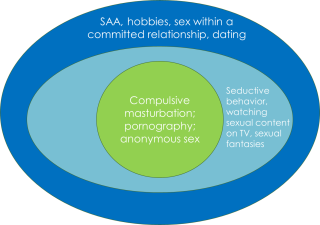Sex
Dispelling Myths About Sex Addiction
What comes to mind when you hear “sex addiction”? It’s time to dispel the myths.
Posted October 23, 2023 Reviewed by Abigail Fagan
Key points
- Compulsive sexual behavior disorder is recognized by the ICD-11 yet often misunderstood.
- Compulsive sexual behavior is not defined by the amount of sexual activity but by the hallmarks of addiction.
- Recovery from compulsive sexual behavior doesn't mean abstaining from sex for the entirety of one's life.
For a subset of individuals, sexual activity can become compulsive, uncontrollable, and continue despite negative consequences. These individuals have what is referred to as compulsive sexual behavior disorder, sex addiction, or hypersexual disorder. The World Health Organization recognizes compulsive sexual behavior disorder in the 11th revision of the International Classification of Diseases. This diagnosis is not recognized in the Diagnostic and Statistical Manual of Mental Disorders (DSM-5; APA, 2013), although the condition can fall under other specified disruptive, impulse-control, and conduct disorder with the specifier of hypersexual disorder (Kafka, 2014).
There are many 12-step and peer support programs dedicated to supporting those with compulsive sexual behavior, formalized assessment instruments to identify the condition, and a specific credential for mental health professionals, the Certified Sex Addiction Therapist (CSAT).
Although the understanding of compulsive sexual behavior is increasing, there are many myths surrounding the concept that should be addressed to facilitate useful discourse.
Myth 1: Compulsive sexual behavior means engaging in too much sex.
It is imperative to differentiate between high involvement in a behavior and a behavioral addiction. Indeed, “amount of time spent engaging” is insufficient for identifying a behavioral addiction. Instead, behavioral addictions are recognized by four hallmarks: compulsivity, loss of control, continued engagement despite negative consequences, and cravings/mental preoccupation in the absence of the behavior (APA, 2013; Giordano, 2021; WHO, 2018). Thus, if someone’s sexual activity is compulsive (not planned or intention, resulting from an impulsive urge; occurring in inappropriate situations), if the individual has lost control over their sexual acts (unsuccessful attempts to reduce or stop sexual acts; broken their own limits for sexual behavior) or if the sexual acts continue despite negative consequences (e.g., financial, physical, relational), and the individual experiences cravings/mental preoccupation when not engaging in sexual activity (fantasizing about next sexual act; reflecting upon previous sexual acts), this indicates that they may have compulsive sexual behavior.
Myth 2: Compulsive sexual behavior is extremely rare.
A recent study by Bothe and colleagues assessed compulsive sexual behavior disorder rates in 42 different countries. The authors found that among over 82,000 participants, 4.84% were at high risk for compulsive sexual behavior disorder (Bothe et al., 2023). For comparison, global depression rates are estimated to be at 4.4% and anxiety at 3.6% (WHO, 2017). Therefore, the number of people affected by compulsive sexual behavior is on par with other mental health concerns.
Myth 3: You can’t have compulsive sexual behavior because sex is naturally rewarding.
Sexual activity is naturally rewarding causing a cascade of neurotransmitters implicated in the experience of reward (e.g., dopamine, endogenous opioids; Doidge, 2017). For a subset of individuals, however, this naturally rewarding act can become compulsive and out of control. There are a number of risk factors that increase an individual’s vulnerability to compulsive sexual behavior such as a genetic predisposition to addiction (including abnormalities of the brain’s reward circuitry; Blum et al., 2012), early trauma and toxic stress (Katehakis, 2009), and early exposure to the supernormal stimulus of pornography (a supernormal stimulus is an artificial exaggeration of a natural instinct that can be more rewarding than the natural stimulus; Barrett, 2010; Doidge, 2007; Hilton, 2013). It is important to note that as with all addictive behaviors, people with compulsive sexual behavior become addicted to changing the way they feel. Sexual acts become their primary means of emotion regulation. Indeed, scholars have found that those with compulsive sexual behavior have poorer emotion regulation skills than those without (Cashwell et al., 2017). Thus, a subset of individuals have risk factors that increase their vulnerability to developing compulsive sexual behavior, and sex becomes the primary means by which they regulate emotions.
Myth 4: Compulsive sexual behavior is synonymous with sex offending.
Compulsive sexual behavior and sex offending are distinct constructs from the legal field and psychology field (Schneider, 1999). However, some individuals with compulsive sexual behavior may offend (their sexual acting out behavior crosses the legal line) and some individuals who have committed a sexual offense may meet the criteria for compulsive sexual behavior disorder. There is reason to believe, however, that the majority of those with compulsive sexual behavior do not offend and the majority of offenders do not meet the criteria for compulsive sexual behavior disorder. For example, among studies of individuals convicted of a sexual offense, the following percentages have met the criteria for compulsive sexual behavior or hypersexuality: 33% (Krueger et al., 2009), 5.8% (Efrati et al., 2019), 12% (Kingston & Bradford, 2013), and 43.9% (Marshall et al., 2008). Additionally, in the study of 87 men who were in treatment for hypersexual disorder, the two most commonly reported compulsive sexual acts were compulsive masturbation (86%) and pornography addiction (81%; Reid et al., 2010). Indeed, scholars have noted differences in patterns, motivations, and the nature of sexual behaviors between those who have compulsive sexual behavior (and do not offend) and those who offend (but do not have compulsive sexual behavior; Delmonico & Griffin, 1997; Smith, 2018). Thus there are distinctions between compulsive sexual behavior and sex offending, although there may be some individuals who meet the criteria for both.
Myth 5: Recovery from compulsive sexual behavior means never engaging in sexual activity again.
Like other addictive behaviors (e.g., food, work, technology), abstinence from compulsive sexual behavior does not mean completely removing sex from a person’s life. Instead, mental health professionals and peer support groups typically rely on some version of the Three Circles Technique (ISO of SAA, Inc., 2000).

The counselor/sponsor and individual with compulsive sexual behavior work to identify the specific compulsive, uncontrollable, sexual acts that lead to negative consequences, and write these down in the innermost of three concentric circles. These are the behaviors from which the individual will abstain. In the middle circle, the individual identifies behaviors that serve as “warning signs” that they are moving toward inner circle behaviors. Finally, the outermost circle contains all behaviors that are healthy, adaptive, and aligned with the individual’s goals and values. Thus, an individual may abstain from pornography use (inner circle behavior), monitor the extent to which they watch sexual content on TV (middle circle behavior), and develop a healthy, consensual dating relationship (outer circle behavior).
References
American Psychiatric Association. (2013). Diagnostic and statistical manual of mental disorders (5th ed.). American Psychiatric Association.
Barrett, D. (2010). Supernormal stimuli: How primal urges overran their evolutionary purpose. W. W. Norton & Company.
Blum, K., Werner, T., Carnes, S., Carnes, P., Bowirrat, A. Giordano, J. … Gold, M. (2012). Sex, drugs, and rock ‘n’ roll: Hypothesizing common mesolimbic activation as a function of reward gene polymorphisms. Journal of Psychoactive Drugs, 44, 38-55.
Bothe, B., Koos, M., Nagy, L., Kraus, S. W., Demetrovics, Z., Potenza, M. N. … Vaillancourt-Morel, M. P. (2023). Compulsive sexual behavior disorder in 42 countries: Insights from the International Sex Survey and introduction of standardized assessment tools. Journal of Behavioral Addictions, 12, 393-401.
Cashwell, C. S., Giordano, A. L., King, K., Lankford, C., & Henson, R. K. (2017). Emotion regulation and sex addiction among college students. International Journal of Mental Health and Addiction, 15, 16 - 27.
Delmonico, D. L., & Griffin, E. (1997). Classifying problematic sexual behavior: A working model. Sexual Addiction & Compulsivity, 4, 91-104.
Doidge, N. (2007). The brain that changes itself: Stories of personal triumph from the frontiers of brain science. Penguin Group.
Efrati, Y., Shukron, O., & Epstein, R. (2019). Compulsive sexual behavior and sexual offending: Differences in genitive schemas, sensation seeking, and impulsivity. Journal of Behavioral Addictions, 8, 432-441.
Giordano, A. L. (2021). A clinical guide to treating behavioral addictions: Conceptualizations, assessments, and clinical strategies. Springer.
Hilton, D. L. (2013). Pornography addiction- A supranormal stimulus considered in the context of neuroplasticity. Socioaffective neuroscience & Psychology, 3, 20767
International Service Organization of SAA, Inc. (2000). Three circles: Defining sexual sobriety in S.A.A. https://saa-recovery.org/literature/three-circles-defining-sexual-sobri…
Kafka, M. P. (2014). What happened to Hypersexual Disorder? Archives of Sexual Behavior, 43, 1259-1261
Katehakis, A. (2009). Affective neuroscience and the treatment of sexual addiction. Sexual Addiction & Compulsivity, 16, 1-31.
Kingston, D. A., & Bradford, J. M. (2013). Hypersexuality and recidivism among sex offenders. Sexual Addiction & Compulsivity, 20, 91-105.
Krueger, R. B., Kaplan, M. S., & First, M. B. (2009). Sexual and other Axis I diagnoses of 60 males arrested for crimes against children involving the internet. CNS Spectrums, 14, 623-631.
Marshall, L. E., Marshall, W. L., Moulden, H. M., & Serran, G. A. (2008). The prevalence of sexual addiction in incarcerated sexual offenders and matched community nonoffenders. Sexual Addiction & Compulsivity, 15, 271-283
Schneider, J. P. (1999). New paradigms for treating sex offenders. Sexual Addiction & Compulsivity, 6, 267-269.
Smith, A. (2018). Sexual addiction and sex offenders. In T. Birchard & J. Benfield (Eds.). The Routledge international handbook of sexual addiction. (pp. 362-372). Routledge/Taylor & Francis Group.
World Health Organization. (2017). Depression and other common mental disorders: Global health estimates. Author.
World Health Organization. (2018). International statistical classification of diseases and related health problems (11th Revision). https://icd.who.int/browse11/l-m/en


